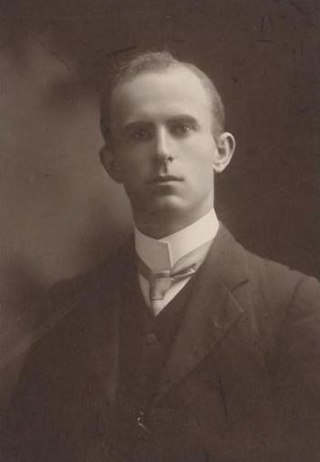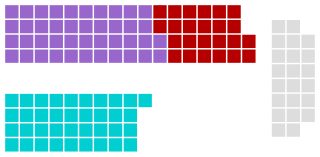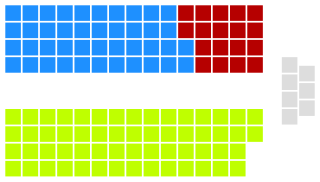Related Research Articles

David Robert Hall was a politician and lawyer in New South Wales, Australia. He came from a political family which included Maggie Hall and he went to leading positions including Attorney General of New South Wales.

Tamworth is an electoral district of the Legislative Assembly in the Australian state of New South Wales. It is represented by the Honourable Kevin Anderson MP of the National Party. In 2019 Anderson was sworn in as the Minister for Better Regulation & Innovation, with additional responsibility for Thoroughbred, Greyhound and Harness Racing codes in New South Wales.
Liverpool Plains was an electoral district of the Legislative Assembly in the Australian state of New South Wales, created in 1859 and including the Liverpool Plains and the extensive pastoral district around the Gwydir River in the northwest of the state. It was created when the seat of Liverpool Plains and Gwydir was divided into two. It was abolished in 1880, and partly replaced by Gunnedah. It was re-created in the 1904 re-distribution of electorates following the 1903 New South Wales referendum, which required the number of members of the Legislative Assembly to be reduced from 125 to 90. It consisted of parts of the abolished seats of Gunnedah, Quirindi, and Wellington. In 1920, with the introduction of proportional representation it was absorbed into Wammerawa, along with Castlereagh and Mudgee. Liverpool Plains was recreated for the 1927 election and finally abolished in 1962. The district was divided between Barwon and Upper Hunter. The sitting member, Frank O'Keefe (Country), successfully contested Upper Hunter at the 1962 election.
Gunnedah was an electoral district of the Legislative Assembly in the Australian state of New South Wales, created in 1880, partly replacing Liverpool Plains, and named after and including Gunnedah. In 1904 it was abolished and replaced by Liverpool Plains and Namoi.
Namoi, known as The Namoi until 1910 was an electoral district of the Legislative Assembly in the Australian state of New South Wales, created in 1880 and named after the Namoi River. It elected two members between 1891 and 1894. In 1894 it was abolished and partly replaced by Narrabri. In 1904, with the downsizing of the Legislative Assembly after Federation, Namoi was recreated, replacing Narrabri and part of Gunnedah. Between 1920 and 1927, it largely absorbed Gwydir and Tamworth and elected three members under proportional representation. In 1927, it was replaced by single-member electorates, mainly Namoi, Tamworth and Barwon. Namoi was abolished in 1950.
John Charles Lucas Fitzpatrick was an Australian politician and journalist.
Liverpool Plains and Gwydir was an electoral district of the Legislative Assembly in the Australian state of New South Wales, created in 1856 and covering what is now known as the North West Slopes region, including the Liverpool Plains and the extensive pastoral district around the Gwydir River in the northwest of the state. It elected two members simultaneously.

The 1901 New South Wales state election was held on 3 July 1901 for all of the 125 seats in the 19th New South Wales Legislative Assembly and it was conducted in single-member constituencies with a first past the post voting system. The Parliamentary Electorates Act of 1893 had conferred the right to vote on every male British subject over 21 years of age who was resident in New South Wales for a year or more. The 19th parliament of New South Wales was dissolved on 11 June 1901 by the Governor, Lord Beauchamp, on the advice of the Premier, John See.
Thomas Henry Hall Goodwin was an Australian politician.
There were 373 candidates contesting 125 seats at the 1901 New South Wales state election which was held on 3 July 1901.

The 1895 New South Wales colonial election was held on 24 July 1895 for all of the 125 seats in the 17th New South Wales Legislative Assembly and it was conducted in single-member constituencies with a first past the post voting system. Section 23 (1) of the Parliamentary Electorates and Elections Act of 1893 conferred a right to vote on 'every male person, being a natural born [British] subject, who shall have resided or had his principal place of abode in New South Wales for a continuous period of one year'. males. The 16th parliament of New South Wales was dissolved on 5 July 1895 by the Governor, Lord Hampden, on the advice of the Premier, George Reid.

Edwin Woodward Turner was an Australian politician.
The 1889 New South Wales colonial election was for 137 members representing 74 electoral districts. The election was conducted on the basis of a simple majority or first-past-the-post voting system. In this election there were 37 multi-member districts returning 100 members. In these multi-member districts each elector could vote for as many candidates as there were vacancies. 10 districts were uncontested. The average number of enrolled voters per seat was 1,955, ranging from Boorowa (1,142) to Canterbury (4,129).
The 1887 New South Wales colonial election was for 124 members representing 74 electoral districts. The election was conducted on the basis of a simple majority or first-past-the-post voting system. In this election there were 35 multi-member districts returning 87 members and 37 single member districts giving a total of 124 members. In the multi-member districts each elector could vote for as many candidates as there were vacancies. 13 districts were uncontested. This was the first election at which there were recognisable political parties. The average number of enrolled voters per seat was 1,984, ranging from Boorowa (1,103) to Canterbury (3,161).
The 1882 New South Wales colonial election was for 113 members representing 72 electoral districts. The election was conducted on the basis of a simple majority or first-past-the-post voting system. In this election there were 32 multi-member districts returning 73 members and 40 single member districts. In the multi-member districts each elector could vote for as many candidates as there were vacancies. 13 districts were uncontested. There was no recognisable party structure at this election. The average number of enrolled voters per seat was 1,701, ranging from East Maitland (984) to Wentworth (2,977).
The 1880 New South Wales colonial election was for 108 members representing 72 electoral districts. The election was conducted on the basis of a simple majority or first-past-the-post voting system. In this election there were 29 multi-member districts returning 68 members and 43 single member districts. In the multi-member districts each elector could vote for as many candidates as there were vacancies. 14 districts were uncontested. There was no recognisable party structure at this election. The average number of enrolled voters per seat was 1,549 for a country seat and 2,361 for an urban one, ranging from East Maitland (966) to Bourke (3,478).
Namoi, an electoral district of the Legislative Assembly in the Australian state of New South Wales had two incarnations, from 1880 to 1894 and from 1904 to 1950.
Liverpool Plains, an electoral district of the Legislative Assembly in the Australian state of New South Wales, had three incarnations, from 1859 to 1880, from 1904 to 1920 and from 1927 to 1962.
Gunnedah, an electoral district of the Legislative Assembly in the Australian state of New South Wales was created in 1880 and abolished in 1904.
Wentworth, an electoral district of the Legislative Assembly in the Australian state of New South Wales, was created in 1859 and abolished in 1904.
References
- 1 2 "Mr Thomas Henry Hall Goodwin (1848-1921)". Former members of the Parliament of New South Wales . Retrieved 23 June 2019.
- ↑ "Writ of election: Gunnedah". New South Wales Government Gazette . No. 558. 30 August 1888. p. 6116. Retrieved 22 September 2020– via Trove.
- ↑ Green, Antony. "1888 Gunnedah by-election". New South Wales Election Results 1856-2007. Parliament of New South Wales . Retrieved 22 September 2020.